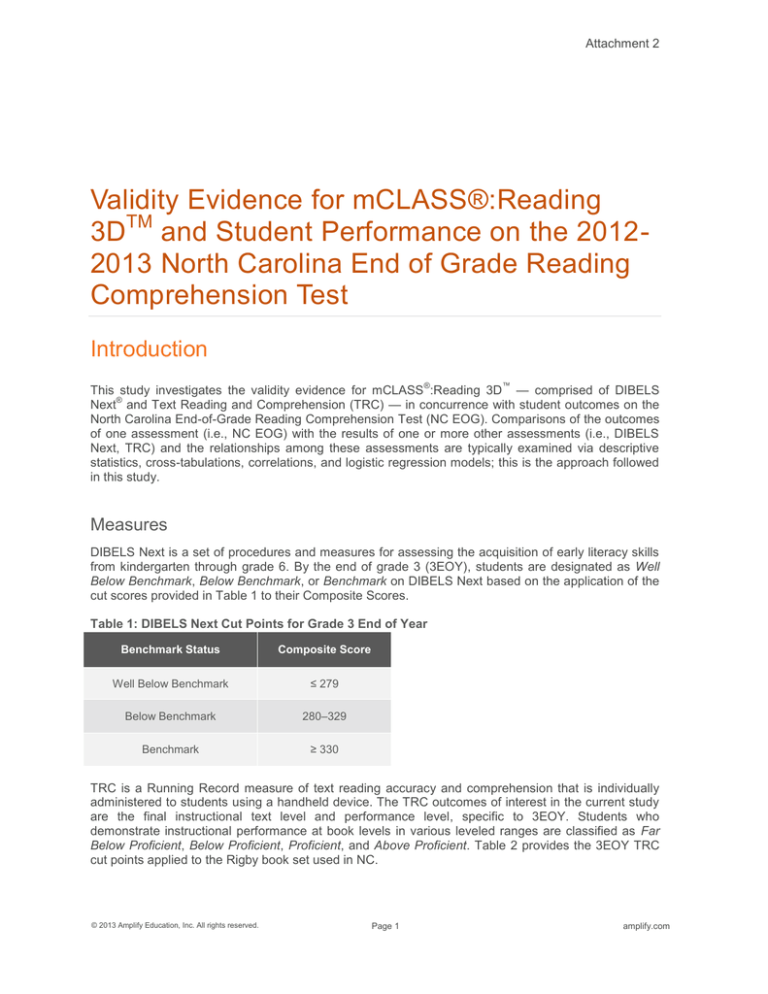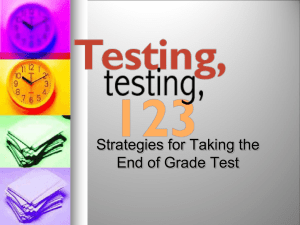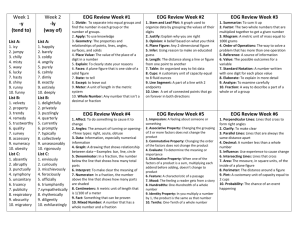
Attachment 2
Validity Evidence for mCLASS®:Reading
3DTM and Student Performance on the 20122013 North Carolina End of Grade Reading
Comprehension Test
Introduction
®
™
This study investigates the validity evidence for mCLASS :Reading 3D — comprised of DIBELS
®
Next and Text Reading and Comprehension (TRC) — in concurrence with student outcomes on the
North Carolina End-of-Grade Reading Comprehension Test (NC EOG). Comparisons of the outcomes
of one assessment (i.e., NC EOG) with the results of one or more other assessments (i.e., DIBELS
Next, TRC) and the relationships among these assessments are typically examined via descriptive
statistics, cross-tabulations, correlations, and logistic regression models; this is the approach followed
in this study.
Measures
DIBELS Next is a set of procedures and measures for assessing the acquisition of early literacy skills
from kindergarten through grade 6. By the end of grade 3 (3EOY), students are designated as Well
Below Benchmark, Below Benchmark, or Benchmark on DIBELS Next based on the application of the
cut scores provided in Table 1 to their Composite Scores.
Table 1: DIBELS Next Cut Points for Grade 3 End of Year
Benchmark Status
Composite Score
Well Below Benchmark
≤ 279
Below Benchmark
280–329
Benchmark
≥ 330
TRC is a Running Record measure of text reading accuracy and comprehension that is individually
administered to students using a handheld device. The TRC outcomes of interest in the current study
are the final instructional text level and performance level, specific to 3EOY. Students who
demonstrate instructional performance at book levels in various leveled ranges are classified as Far
Below Proficient, Below Proficient, Proficient, and Above Proficient. Table 2 provides the 3EOY TRC
cut points applied to the Rigby book set used in NC.
© 2013 Amplify Education, Inc. All rights reserved.
Page 1
amplify.com
© 2013 Amplify Education, Inc. All rights reserved.
Page 2
Table 2: TRC Cut Points for Grade 3 End of Year
Performance Level
Book Level
Far Below Proficient
≤M
Below Proficient
N-O
Proficient
P-Q
Above Proficient
≥R
The North Carolina End-of-Grade Reading Comprehension Tests (NC EOG) are administered within
the last three weeks of each school year from grades 3–8 (North Carolina Department of Public
Instruction, 2009). Four scale score ranges were established to determine a student’s achievement
level, which indicates the degree to which a student is prepared to succeed at the next grade level. A
student who scores at achievement Level I or Level II shows limited or partial command of the
knowledge and skills contained in the Common Core State Standards (CCSS) Reading Standards for
Literature, Informational Text, and Language. A student who scores at achievement Level III or Level
IV shows solid or superior command of the knowledge and skills contained in the Common Core State
Standards (CCSS) Reading Standards for Literature, Informational Text, and Language. Grade 3
students in North Carolina are required to score at achievement Level III or above in order to continue
on to grade 4 in the next school year. Table 3 provides the scaled score cut points for each of the
performance levels for the grade 3 NC EOG.
Table 3: NC EOG Reading Comprehension Test Cut Points for Grade 3
Performance Level
EOG Scaled Score
Level I
≤ 431
Level II
432–441
Level III
442–451
Level IV
≥ 452
Sample
Of the 64,515 unique grade 3 students assessed using mCLASS:Reading 3D in the spring of the
2012–2013 school year, 56,999 students provided complete DIBELS Next and TRC results. The
mCLASS:Reading 3D data were then matched to the full ‘12–‘13 NC EOG data (n = 102,780 unique
students). Of the complete mCLASS: Reading 3D data, 53,890 unique students were matched to their
NC EOG data, yielding a 95 percent match rate. This matched sample contains 850 schools; 49
percent of the student sample is female and 51 percent is male; 50 percent of the students identify as
White, 26 percent as Black or African American, 16 percent as Hispanic or Latino, and 4 percent as
Multiracial.
© 2013 Amplify Education, Inc. All rights reserved.
Page 3
Results
Analysis 1: Describing and Correlating mCLASS:Reading 3D and NC
EOG Performance
Table 5 summarizes descriptive statistics for DIBELS Next Composite Scores and TRC final
instructional reading levels at 3EOY and NC EOG scaled scores. The TRC text levels were converted
to numeric values to facilitate analysis (PC = 2, RB = 3, A = 4, B = 5, C = 6, D = 7, E = 8, F = 9, G =
10, H = 11, I = 12, J = 13, K = 14, L = 15, M = 16, N = 17, O = 18, P = 19, Q = 20, R = 21, S = 22, T =
23, U = 24, V = 25, W = 26.).
Table 5: Descriptive Statistics for DIBELS Next Composite Score, TRC Level, NC EOG Reading
Assessment Scale Score.
Measure
DIBELS Next
TRC*
NC EOG
Mean
375.25
19.10 (P)
439.03
SD
119.43
3.99
10.15
Median
379
20 (Q)
440
Minimum
0
2 (PC)
406
Maximum
815
24 (U)
462
* Numeric equivalents presented with alphabetic text levels in parentheses.
Table 6 presents correlations among DIBELS Next Composite Score, TRC, and NC EOG. The
correlations with NC EOG were strong for both TRC final instructional reading level (r = 0.71, p < 0.05)
and DIBELS Composite Score (r = 0.74, p < 0.05).
Table 6: Correlations between DIBELS Next Composite Score, TRC Level, and NC EOG Reading
Assessment Scale Score.
Measure
DIBELS NEXT
TRC
DIBELS Next
—
0.72*
TRC
0.72*
—
NC EOG
0.74*
0.71*
* p < 0.05.
Table 7 presents the frequency with which students in each DIBELS Next benchmark status category
(Well Below Benchmark, Below Benchmark, and Benchmark) and TRC performance level category
(Far Below, Below, Proficient, and Above) achieved scores within each performance level on NC
EOG. Additionally, percentages of students in each NC EOG performance level for each combination
of DIBELS Next and TRC performance level are presented.
Figure 1 presents these results graphically. Each of the vertical bars displays the percentage of
students at each NC EOG performance level for the combinations of DIBELS Next and TRC
performance levels. Above the bars, each window in the graphic corresponds to DIBELS Next
performance levels while the values below the horizontal axis indicate the TRC performance levels.
Generally, as student performance increases on both DIBELS Next and TRC, so too does
performance on NC EOG. Of note, those students who performed highest on both DIBELS Next and
TRC demonstrated the highest rate of achieving Level IV on the NC EOG (22%). All other
performance on DIBELS Next and TRC yielded much lower rates of Level IV outcomes on NC EOG
(0–5%)
© 2013 Amplify Education, Inc. All rights reserved.
Page 4
A chi-squared test of independence indicates that the frequency distribution of performance levels on
2
the NC EOG significantly relates to DIBELS Next and TRC performance levels (χ = 89,485, df = 39, p
< 0.05).
Table 7: Distribution of NC EOG Performance Levels by Combined DIBELS Next and TRC
Performance Levels
NC EOG (Freq.)
DIBELS Next
TRC
Well Below
Far Below
5789
1225
64
0
7078
82%
Below
1078
703
78
1
1860
Proficient
341
394
65
2
Above
87
160
37
Far Below
1219
1070
Below
674
Proficient
Above
Below
Benchmark
Total
1
2
3
NC EOG (%)
4
Total
1
2
3
4
17%
1%
0%
58%
38%
4%
0%
802
43%
49%
8%
0%
2
286
30%
56%
13%
1%
144
2
2435
50%
44%
6%
0%
1086
267
16
2043
33%
53%
13%
1%
380
991
326
10
1707
22%
58%
19%
1%
182
608
325
31
1146
16%
53%
28%
3%
Far Below
803
1791
562
32
3188
25%
56%
18%
1%
Below
677
2382
1275
83
4417
15%
54%
29%
2%
Proficient
576
3577
3255
408
7816
7%
46%
42%
5%
Above
402
4774
11264
4672
21112
2%
23%
53%
22%
Total
12208
18761
17662
5259
53890
23%
35%
33%
10%
Figure 1: Percentage of Students in NC EOG Performance Levels by DIBELS Next Benchmark
Status and TRC Performance Level
© 2013 Amplify Education, Inc. All rights reserved.
Page 5
More simply, Table 8 presents the cross-tabulation of DIBELS Next, TRC, and NC EOG performance
according to proficiency status only. For this analysis, students were classified as proficient if they
reached Benchmark on DIBELS Next or Proficient/Above Proficient on TRC; each measure represents
separate proficiencies, so students could be proficient on neither, one, or both measures. For the NC
EOG, proficiency is defined as achieving Level III or IV.
It is clear from the results in Table 8 that students who were non-proficient on both DIBELS Next and
TRC were also non-proficient on the NC EOG (96%). Also, proficiency on both DIBELS Next and TRC
strongly corresponds to proficiency on the NC EOG (68%).
Table 8: Distribution of Proficiency across NC EOG, DIBELS Next, and TRC Performance
Levels
DIBELS Next
Non-Prof.
Proficient
TRC
Non-Prof.
Proficient
Non-Prof.
Proficient
TOTAL
NC EOG (Freq.)
Non-Prof.
Proficient
12844
572
3143
798
5653
1952
9329
19,599
30969
22921
Total
13416
3941
7605
28,928
53890
NC EOG (%)
Non-Prof.
Proficient
96%
4%
80%
20%
74%
26%
32%
68%
57%
43%
Analysis 2: Estimation of Grade 3 Student NC EOG Proficiency
The previous section describes evidence for the concurrent validity of mCLASS:Reading 3D according
to observed data. Additional validity evidence is provided in this section: logistic regression estimates
NC EOG proficiency from DIBELS Next and TRC performance at 3EOY, where proficiency is defined
as Level III and Level IV on NC EOG. The previous results describe the observed data; this section
uses statistical analysis to generalize the results’ application beyond the current analysis.
A scatter plot of NC EOG scale scores and 3EOY DIBELS Next scores indicates an approximately
linear relationship (Figure 2). Comparison of the least squares regression line (red) and lowess curve
(blue) indicates that the relationship between NC EOG scale score and DIBELS Next score exhibits
moderate curvature, particularly for more extreme DIBELS Next scores. This result appears due to a
possible ceiling effect on the NC EOG, where the maximum scale score is 462. Despite this mild
curvilinearity, the relationship is still adequately described as linear.
Further, a scatter plot of NC EOG scale score and 3EOY TRC level (Figure 3) also indicates an
approximately linear relationship, and the lowess curve (blue) closely matches the regression line
(red), with mild curvature at the lowest TRC levels.
© 2013 Amplify Education, Inc. All rights reserved.
Page 6
Figure 2: Scatter plots of NC EOG Scaled Scores with DIBELS Next Composite Scores
Figure 3: Scatter plots of NC EOG Scaled Scores with TRC Levels
© 2013 Amplify Education, Inc. All rights reserved.
Page 7
Given the approximately linear relationships between the mCLASS:Reading 3D measures and NC
EOG scale scores and the approximately normal distribution of the NC EOG scale scores, it is
appropriate to employ DIBELS Next Composite Scores and TRC levels in the following logistic
regression model estimating NC EOG proficiency:
NC EOG (Not Proficient or Proficient) = β0 + β1(DIBELS) + β2(TRC)
This model estimates the probability that a student is proficient on NC EOG, given the student’s
DIBELS Next Composite Score and TRC level. As shown in Table 8, both DIBELS Next Composite
Scores and TRC levels strongly correspond to NC EOG reading performance levels.
Table 8: Logistic Regression Model Coefficients and Statistics
Coefficient
Intercept
DIBELS Next Composite Score
TRC Level
β
–10.37
0.01
0.27
SE(β)
0.09
0.00
0.00
Z
–109.31
70.50
58.97
p
< 0.01
< 0.01
< 0.01
Estimates of Proficient or Non-Proficient on NC EOG produced by the logistic regression model based
on DIBELS Next Composite Scores and TRC levels are found to be correct for 79 percent of students.
(Table 9). Finally, of those students whose proficiency was incorrectly estimated, the majority were
false negatives (11%), not false positives, meaning that mCLASS: Reading 3D estimated NC EOG
performance to be non-proficient when students’ observed performance was, in fact, Proficient (or
better).
Table 9: Observed and Predicted NC EOG Proficiency
Predicted
Not Proficient
Proficient
Observed
Not Proficient
47.53%
9.94%
Proficient
10.80%
31.73%
Conclusion
This study examines the concurrent validity of the mCLASS:Reading 3D assessment with respect to
the North Carolina End-of-Grade (NC EOG) Reading Comprehension Test. mCLASS:Reading 3D
consists of DIBELS Next and the Text Reading and Comprehension (TRC) measures administered at
the end of the school year. Correspondence of these two measures with Grade 3 NC EOG
performance in spring of the ‘12–‘13 school year was examined.
This study finds that mCLASS:Reading 3D is an effective indicator of NC EOG performance. Students
who were non-proficient on both DIBELS Next and TRC were most frequently non-proficient on the NC
EOG (96%) while students proficient on both DIBELS Next and TRC were also most often proficient
(or above) on the NC EOG (68%). Statistical analysis suggests mCLASS: Reading 3D provides
adequate concurrent validity evidence as scores strongly and positively correlate with NC EOG —
DIBELS Next demonstrated a correlation of r = 0.74 with NC EOG and TRC correlated with NC EOG
at r = 0.71. Lastly, a logistic regression model estimated NC EOG scores from mCLASS: Reading 3D
performance — extending interpretation beyond the current administration period and population of
students. This statistical analysis demonstrated that the combination of DIBELS Next and TRC has an
overall accuracy of 79 percent in estimating proficiency on the Grade 3 NC EOG reading
comprehension assessment.
© 2013 Amplify Education, Inc. All rights reserved.
Page 8



